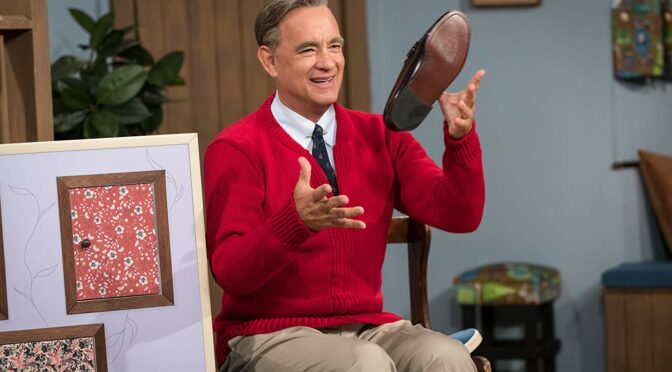Fred Rogers is a figure at the centre of childhood culture in very few places outside the United States. As such, non-Americans might be expected to gain little of interest from a film marketed as a biopic of the fondly regarded children’s TV presenter. In the hands of Marielle Heller, however, A BEAUTIFUL DAY IN THE NEIGHBORHOOD becomes a touching ode to the strength of forgiveness and kindness against the corrosive influence of cynicism and grudges and what we choose to carry forward in life to future generations.
Lloyd Vogel (Matthew Rhys) is an investigative journalist at Esquire in New York City, frustrated when he is asked to produce a short piece on Fred Rogers (Tom Hanks), the venerated host of Mister Rogers’ Neighborhood, for an edition on ‘heroes’. A hardbitten cynic and new father, Lloyd resents his absent father for abandoning the family and the older man’s philandering, and we see him getting into a physical scrap with his father at his sister’s wedding as the film begins. Determined to not write the puff piece requested, Lloyd looks to get underneath Fred Rogers’ veneer and expose what he views as a nice guy act. Instead, he begins to reconcile his past and current worldview with his own family history and what he owes to his wife and newborn son.
A widely beloved bastion of kindness and gentleness, Fred Rogers himself is probably – to be frank – a rather dull and benign proposition for a conventional biopic. Director Marielle Heller – fresh off one of 2019’s best films in CAN YOU EVER FORGIVE ME? – and writers Noah Harpster and Micah Fitzerman-Blue seem to understand this all too well. Instead, the story is based on the Esquire article that sets the film’s events in motion, and largely centres on the journalist who wrote it: Lloyd is a fictionalised version of the real author Tom Junod. The creative team understand – as does the onscreen Fred Rogers here – that any power Fred Rogers has lies in what he means to other people and the effect he has on them.
“The creative team understand – as does the onscreen Fred Rogers here – that any power Fred Rogers has lies in what he means to other people and the effect he has on them.”
Within A BEAUTIFUL DAY IN THE NEIGHBORHOOD there is both a probing inquiry into the stifled emotion of traditional masculinity and the more recent move towards openness about one’s feelings. Lloyd strives to be stoic and realistic, not realising that the combination of this with his previous childhood trauma makes him cynical and closed-off. Positive emotions are not things to be treasured or displayed, but crutches – pillars we cannot rely on lest they are pulled away from us. The almost uncomfortable levels of positivity and understanding displayed by Rogers seem unrealistically patient to him and cannot possibly be real. It is only through writing about the man that Lloyd – and the audience – comes to understand these are not supernatural powers, but choices made every day about how to live life and behave towards those around us. Adults are frequently even less capable of processing events and emotions than the children they look to raise.
On a technical level, Heller’s film allows the two central performances to lead the way in a film that – in different hands – could be a schmaltzy nostalgia-fest. The sound design is notably excellent in this regard, with the use of silence (and transition back) during one restaurant sequence exquisitely highlighting the film’s central ideas of the value of patience and calm. The production design evokes a sense of time and place, specifically New York City in the late 1990s, without needing Heller to fetishise it in her shotmaking. In this respect it is handled with the same skill she managed early 1990s New York with CAN YOU EVER FORGIVE ME?.
“There are hints to a more complicated interior life belonging to Rogers alone, one that isn’t denied but does not need to be explored to break down the concept of an unimpeachable saint [and the film] challenges the idea that people can destroy their value through bad choices.”
All this allows Hanks to fully embody his role as Fred Rogers, and his performance is not a shallow hagiographical one. There are hints to a more complicated interior life belonging to Rogers alone, one that isn’t denied but does not need to be explored to break down the concept of an unimpeachable saint. The relationship that develops between him and Lloyd, which draws Lloyd’s father into its sphere of influence, is one that challenges the idea that people can destroy their value through bad choices. The subsequent redrawing of lines in Lloyd’s family relationships preaches forgiveness, even if not forgetting. Atoning for past behaviour requires acknowledgement of it. Reconciling past experiences with current emotions requires an understanding of how they affected you. Processing all of it requires empathy and patience.
Some of the kookier elements sit aside from this: a nightmare sequence set in The Neighborhood of Make-Believe, and transitional establishing shots done in the style of Mister Rogers’ Neighborhood. They don’t necessarily highlight the film’s central concerns but perhaps deliver that warm nostalgia the actual narrative and performances wisely eschew.
A BEAUTIFUL DAY IN THE NEIGHBORHOOD is a more intelligent and lasting biopic than most conventional modern attempts. The film delivers a better understanding of what Mr Rogers means to the young people who watched him and the parents who entrusted their children’s attention to him. From outside North America looking in, Mister Rogers’ Neighborhood seems quaint and even twee. Heller’s film, however, provides a nostalgic window on how to process emotion, the power of forgiveness, and the complicated interior lives of those we share emotional space with.

